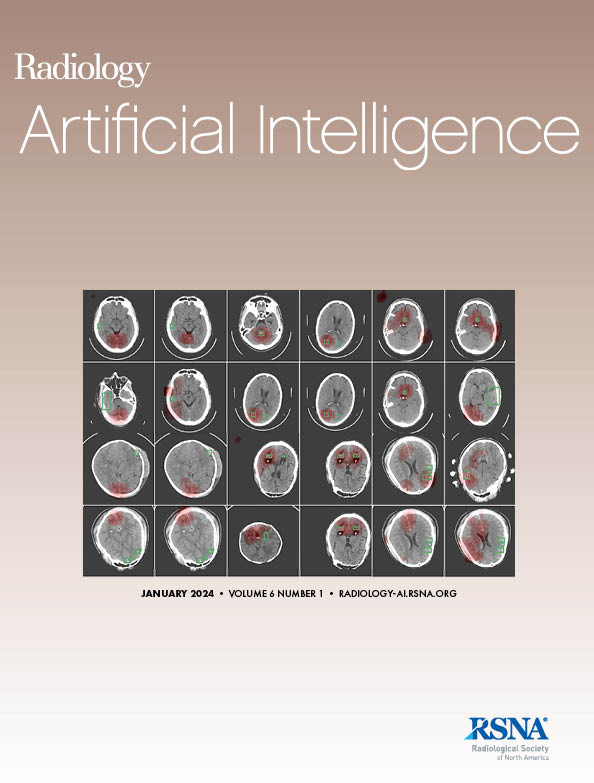Chaojie Zhang, Shengjia Chen, Ozkan Cigdem, Haresh Rengaraj Rajamohan, Kyunghyun Cho, Richard Kijowski, Cem M Deniz
下载PDF
{"title":"MR-Transformer: A Vision Transformer-based Deep Learning Model for Total Knee Replacement Prediction Using MRI.","authors":"Chaojie Zhang, Shengjia Chen, Ozkan Cigdem, Haresh Rengaraj Rajamohan, Kyunghyun Cho, Richard Kijowski, Cem M Deniz","doi":"10.1148/ryai.240373","DOIUrl":null,"url":null,"abstract":"<p><p>Purpose To develop a transformer-based deep learning model-MR-Transformer-that leverages ImageNet pretraining and three-dimensional spatial correlations to predict the progression of knee osteoarthritis to total knee replacement using MRI. Materials and Methods This retrospective study included 353 case-control matched pairs of coronal intermediate-weighted turbo spin-echo (COR-IW-TSE) and sagittal intermediate-weighted turbo spin-echo with fat suppression (SAG-IW-TSE-FS) knee MRI scans from the Osteoarthritis Initiative database, with a follow-up period up to 9 years, and 270 case-control matched pairs of coronal short-tau inversion recovery (COR-STIR) and sagittal proton-density fat-saturated (SAG-PD-FAT-SAT) knee MRI scans from the Multicenter Osteoarthritis Study database, with a follow-up period up to 7 years. Performance of the MR-Transformer to predict the progression of knee osteoarthritis was compared with that of existing state-of-the-art deep learning models (TSE-Net, 3DMeT, and MRNet) using sevenfold nested cross-validation across the four MRI tissue sequences. Results Among the 353 Osteoarthritis Initiative case-control pairs, 215 were women (mean age, 63 years ± 8 [SD]); among the 270 Multicenter Osteoarthritis Study case-control pairs, 203 were women (mean age, 65 years ± 7). The MR-Transformer achieved areas under the receiver operating characteristic curve (AUCs) of 0.88 (95% CI: 0.85, 0.91), 0.88 (95% CI: 0.85, 0.90), 0.86 (95% CI: 0.82, 0.89), and 0.84 (95% CI: 0.81, 0.87) for COR-IW-TSE, SAG-IW-TSE-FS, COR-STIR, and SAG-PD-FAT-SAT, respectively. The model achieved a higher AUC than that of 3DMeT for all MRI sequences (<i>P</i> < .001). The model showed the highest sensitivity of 83% (95% CI: 78, 87) and specificity of 83% (95% CI: 76, 88) for the COR-IW-TSE MRI sequence. Conclusion Compared with the existing deep learning models, the MR-Transformer exhibited state-of-the-art performance in predicting the progression of knee osteoarthritis to total knee replacement using MRI scans. <b>Keywords:</b> MRI, Knee, Prognosis, Supervised Learning <i>Supplemental material is available for this article.</i> © RSNA, 2025.</p>","PeriodicalId":29787,"journal":{"name":"Radiology-Artificial Intelligence","volume":" ","pages":"e240373"},"PeriodicalIF":13.2000,"publicationDate":"2025-09-01","publicationTypes":"Journal Article","fieldsOfStudy":null,"isOpenAccess":false,"openAccessPdf":"https://www.ncbi.nlm.nih.gov/pmc/articles/PMC12464714/pdf/","citationCount":"0","resultStr":null,"platform":"Semanticscholar","paperid":null,"PeriodicalName":"Radiology-Artificial Intelligence","FirstCategoryId":"1085","ListUrlMain":"https://doi.org/10.1148/ryai.240373","RegionNum":0,"RegionCategory":null,"ArticlePicture":[],"TitleCN":null,"AbstractTextCN":null,"PMCID":null,"EPubDate":"","PubModel":"","JCR":"Q1","JCRName":"COMPUTER SCIENCE, ARTIFICIAL INTELLIGENCE","Score":null,"Total":0}
引用次数: 0
引用
批量引用
Abstract
Purpose To develop a transformer-based deep learning model-MR-Transformer-that leverages ImageNet pretraining and three-dimensional spatial correlations to predict the progression of knee osteoarthritis to total knee replacement using MRI. Materials and Methods This retrospective study included 353 case-control matched pairs of coronal intermediate-weighted turbo spin-echo (COR-IW-TSE) and sagittal intermediate-weighted turbo spin-echo with fat suppression (SAG-IW-TSE-FS) knee MRI scans from the Osteoarthritis Initiative database, with a follow-up period up to 9 years, and 270 case-control matched pairs of coronal short-tau inversion recovery (COR-STIR) and sagittal proton-density fat-saturated (SAG-PD-FAT-SAT) knee MRI scans from the Multicenter Osteoarthritis Study database, with a follow-up period up to 7 years. Performance of the MR-Transformer to predict the progression of knee osteoarthritis was compared with that of existing state-of-the-art deep learning models (TSE-Net, 3DMeT, and MRNet) using sevenfold nested cross-validation across the four MRI tissue sequences. Results Among the 353 Osteoarthritis Initiative case-control pairs, 215 were women (mean age, 63 years ± 8 [SD]); among the 270 Multicenter Osteoarthritis Study case-control pairs, 203 were women (mean age, 65 years ± 7). The MR-Transformer achieved areas under the receiver operating characteristic curve (AUCs) of 0.88 (95% CI: 0.85, 0.91), 0.88 (95% CI: 0.85, 0.90), 0.86 (95% CI: 0.82, 0.89), and 0.84 (95% CI: 0.81, 0.87) for COR-IW-TSE, SAG-IW-TSE-FS, COR-STIR, and SAG-PD-FAT-SAT, respectively. The model achieved a higher AUC than that of 3DMeT for all MRI sequences (P < .001). The model showed the highest sensitivity of 83% (95% CI: 78, 87) and specificity of 83% (95% CI: 76, 88) for the COR-IW-TSE MRI sequence. Conclusion Compared with the existing deep learning models, the MR-Transformer exhibited state-of-the-art performance in predicting the progression of knee osteoarthritis to total knee replacement using MRI scans. Keywords: MRI, Knee, Prognosis, Supervised Learning Supplemental material is available for this article. © RSNA, 2025.
MR-Transformer:一种基于视觉变压器的深度学习模型,用于MRI全膝关节置换术预测。
“刚刚接受”的论文经过了全面的同行评审,并已被接受发表在《放射学:人工智能》杂志上。这篇文章将经过编辑,布局和校样审查,然后在其最终版本出版。请注意,在最终编辑文章的制作过程中,可能会发现可能影响内容的错误。目的:开发基于变压器的深度学习模型mr - transformer,该模型利用ImageNet预训练和三维(3D)空间相关性,通过MRI预测膝关节骨关节炎向TKR的进展。材料和方法本回顾性研究包括353对病例对照匹配的冠状中权重涡轮自旋回波(COR-IW-TSE)和矢状中权重涡轮自旋回波伴脂肪抑制(sagw - tse - fs)膝关节mri,来自骨关节炎倡议(OAI)数据库,随访时间长达9年。以及来自多中心骨关节炎研究(MOST)数据库的270对匹配病例对照的冠状面短tau反转恢复(COR-STIR)和矢状面质子密度脂肪饱和(SAG-PD-FAT-SAT)膝关节mri,随访期长达7年。通过对四个MRI组织序列进行七倍嵌套交叉验证,将MR-Transformer预测膝关节骨性关节炎进展的性能与现有最先进的深度学习模型(TSE-Net、3DMeT和MRNet)进行比较。结果MR-Transformer在COR-IW-TSE、SAG-IW-TSE-FS、COR-STIR和SAG-PD-FAT-SAT的受试者工作特征曲线(auc)下的面积分别为0.88 (95% CI: 0.85, 0.91)、0.88 (95% CI: 0.85, 0.90)、0.86 (95% CI: 0.82, 0.89)和0.84 (95% CI: 0.81, 0.87)。在所有MRI序列上,该模型的AUC均高于3DMeT (P < 0.001)。该模型对co - iw - tse MRI序列的最高敏感性为83% (95% CI: 78,87%),特异性为83% (95% CI: 76,88%)。与现有的深度学习模型相比,MR-Transformer在利用mri预测膝关节骨关节炎向TKR的进展方面表现出了最先进的性能。©RSNA, 2025年。
本文章由计算机程序翻译,如有差异,请以英文原文为准。

 求助内容:
求助内容: 应助结果提醒方式:
应助结果提醒方式:


